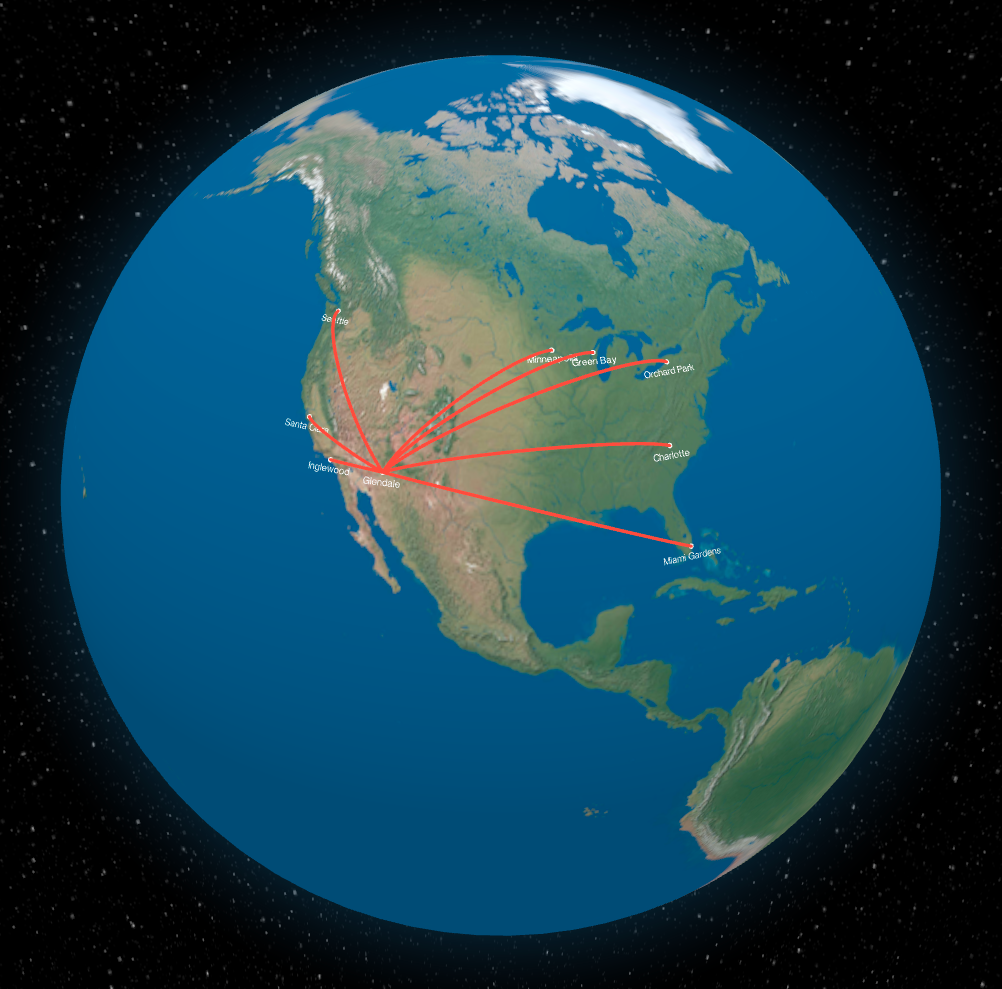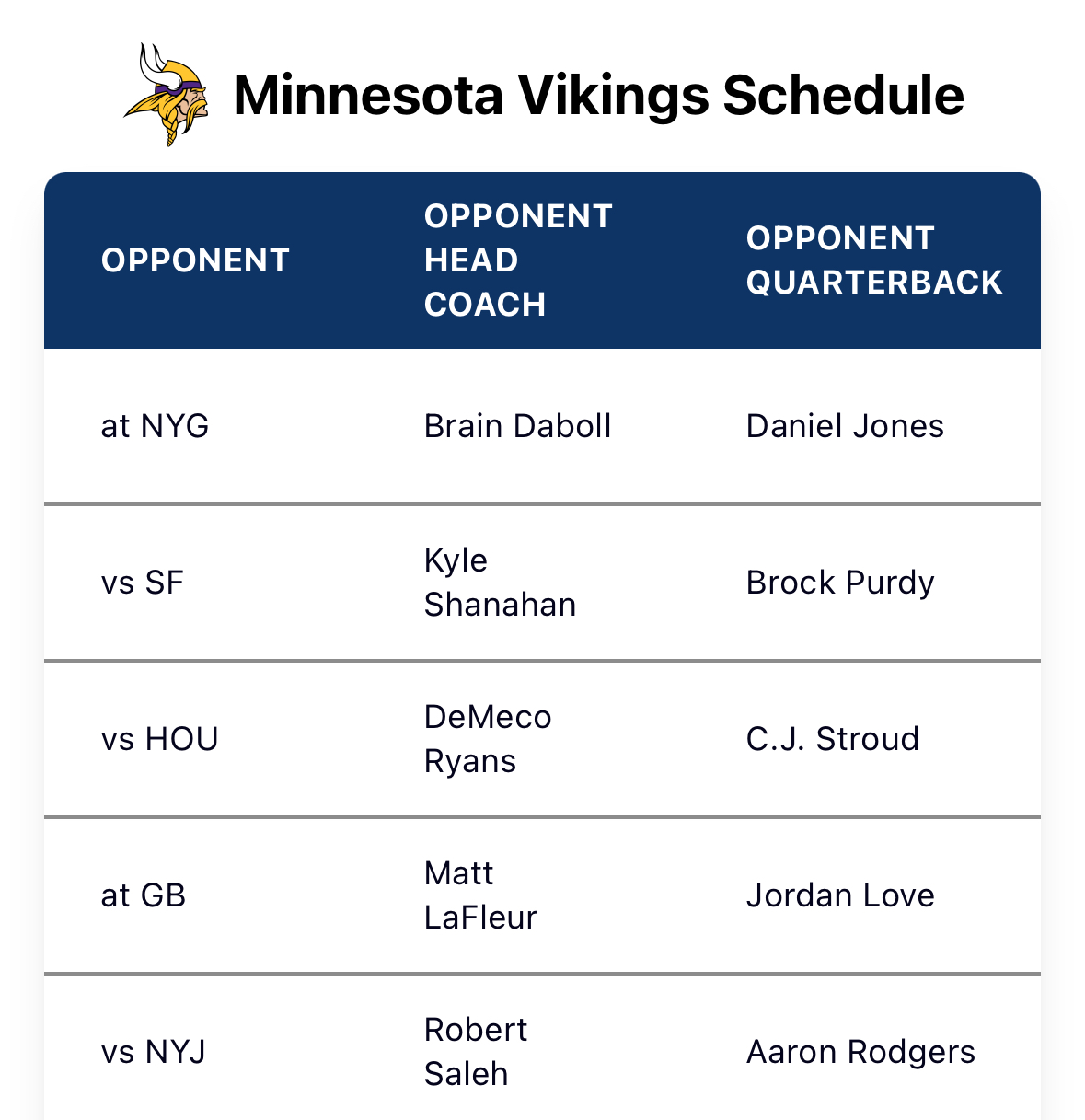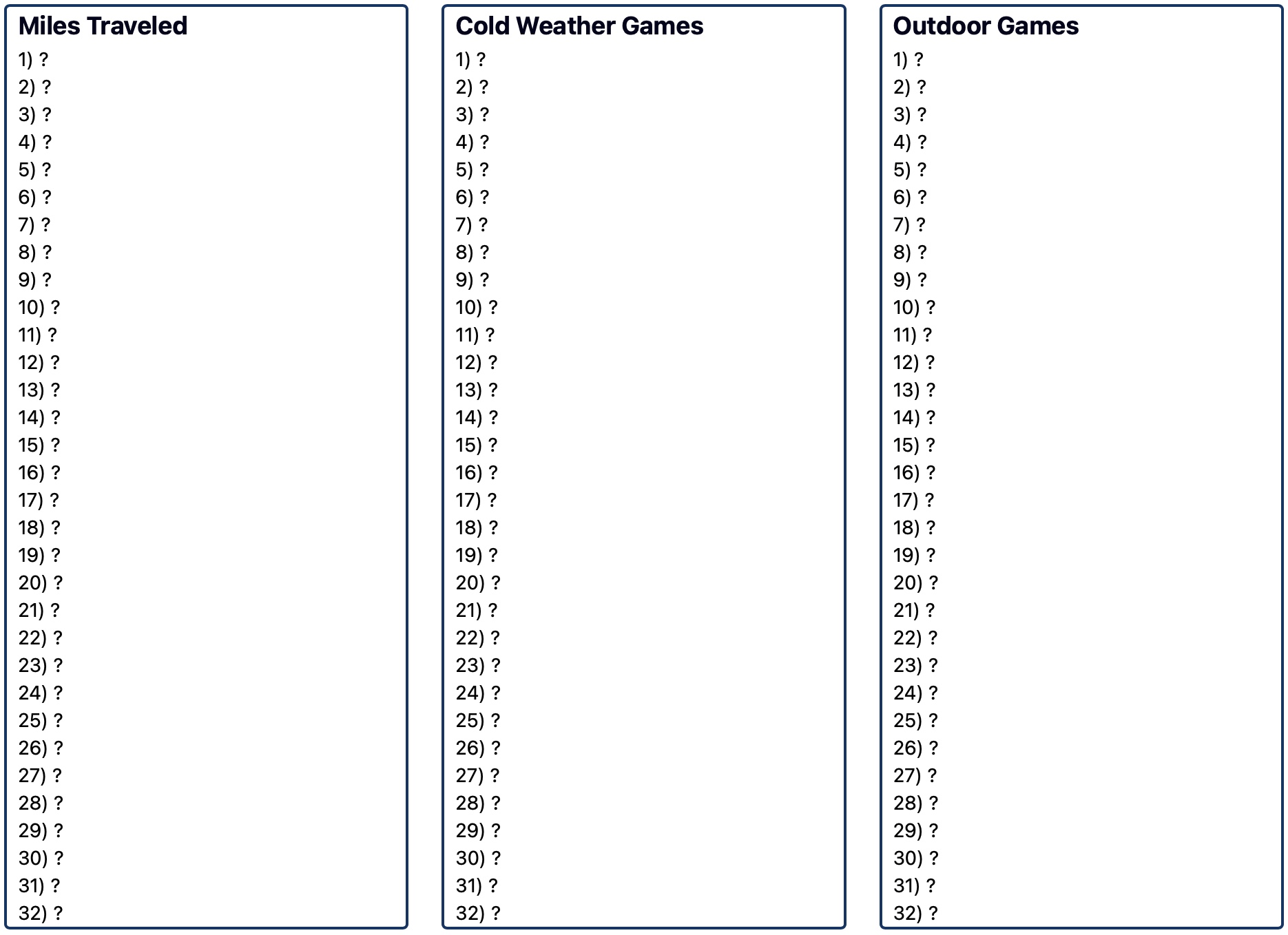Find an Edge in
NFL Team Schedules

Visualize Victory:
3D NFL
Travel
Maps
Embark on a visual journey through the NFL season. Dive into an interactive 3D map that details every team's travel routes and game locations.
Travel VisualizationMaster the Season:
In Depth
NFL
Schedules
Your all-in-one guide to NFL team schedules. Analyze critical opponent details, including head coach, quarterback, venue information, and more.
In Depth Schedule

Rankings Revealed:
NFL Team
Rankings
Uncover the leaders and losers with our comprehensive rankings. Analyze and compare team logistics across the league.
Team RankingsNFL Schedules are More Than a List of Opponents
FootballRoutes helps you dig deeper into the logistical challenges teams face throughout the season.
Travel
Visualize your team's travel across the United States and beyond.
Coach & Quarterback
The two most important factors determining wins and losses, view your schedule as a sequence of coaches and quarterbacks.
Playing Environment
From artificial turf to grass, outdoor stadiums to domes, digest the various playing environments your team will have to withstand during the season.
Calendar Challenges
From holiday games to prime time matchups, schedule irregularities can disrupt player performance, a factor often overlooked by many.
Streaks
See which teams get lucky with consecutive home weeks and which ones face the tough luck of multiple weeks on the road.
Opponent Advantages
Some opponents may have longer rest periods before facing your team, a crucial factor to consider when evaluating schedules.
Frequently Asked Questions
What is FootballRoutes?
FootballRoutes is your comprehensive tool for analyzing NFL team schedules. While an ordinary NFL team schedule shows who the team plays and when, it often overlooks the off-field challenges these schedules create. FootballRoutes serves as your ultimate NFL team schedule hub, where you can visually explore how far a team must travel, analyze the schedule by opposing quarterbacks or other critical opponent details, and compare your team's schedule against others in the league. FootballRoutes allows you to view NFL team schedules from a different perspective, allowing you to gain an edge when evaluating teams' expectation for the upcoming season.
Why did you create FootballRoutes?
Every year, when NFL team schedules are released, fans eagerly anticipate mapping out their Sundays (and Mondays, Thursdays, and occasionally other days too). For fans, it's an exciting itinerary of games to watch. But for the teams, it's more than just dates and matchups; it's a real itinerary with significant travel demands. Teams must navigate thousands of miles of travel, diverse climates, and extended periods away from home. The impact of these NFL team schedules varies, with some teams facing tougher logistical challenges than others. I created FootballRoutes to analyze and compare these itineraries, revealing which teams are in for a smooth season and which are facing a rough road ahead.
How do you calculate "Miles Traveled"?
"Miles Traveled" is calculated using the distance in miles to and from each away/neutral game location. For example, assume the New England Patriots are set to play the Chicago Bears in Chicago. There are roughly 840 miles between Foxborough, MA and Chicago, IL. So the Patriots would have to travel ~840 miles to get to Chicago, and then another ~840 miles to get back home. So a total of ~1,680 miles would be added to the Patriots' miles traveled calculation for this particular week. It is always assumed the traveling team returns home after an away/neutral site game, even if their next game is played close by.
How do you calculate "Expected Cold Weather Games"?
"Expected Cold Weather Games" are defined as games played outdoors in November, December, January, or February. Games held in retractable domes do not count towards this metric, because it is assumed the dome would be closed if the weather is cold.
How do you calculate "Outdoor Games"?
"Outdoor Games" are games played in outdoor-only venues. Retractable domes do not count towards this measure, because if the weather is poor, it is assumed the dome would be closed. Therefore, it is not meaningful to add retractable domes to the calculation if they're virtually only kept open in pristine weather.
How do you calculate "Timezone Changes"?
"Timezone changes" are counted when a team must travel to a game outside of their home timezone. One timezone change is counted on the way to the game, and another for the change on the return home. All timezone changes count as one timezone change, no matter how many hours are actually lost or gained from the home timezone.
How do you calculate "Prime Time Games"?
"Prime Time Games" are defined as those played in the 8:15pm or 8:20pm ET window. These games are typically played at night on Sundays, Mondays, and Thursdays.
How do you calculate "Holiday Games"?
"Holiday Games" is limited to New Year's Day, Martin Luther King Jr. Day, Washington's Birthday, Memorial Day, Independence Day, Labor Day, Columbus Day, Veterans Day, Thanksgiving, and Christmas.
How do you calculate "Max. Consecutive Homes Games"?
"Max. Consecutive Homes Games" is defined as the longest streak throughout the year that each team remains at home. A bye week is considered a week at home. For example, if the Minnesota Vikings play the Jets at home, then have a bye the next week, and then play the Lions at home, this would count as a three-week home streak. This would assume the Vikings' game before the Jets was not played in Minnesota nor the Vikings' game after the Lions. If this was the longest home streak the Vikings had all year, their max. consecutive home game value would be three.
How do you calculate "Max. Consecutive Away Weeks"?
"Max. Consecutive Away Weeks" is calculated similar to "Max. Consecutive Home Weeks". This would be the longest streak throughout the year each team remains on the road. While we understand teams typically return home in between away games, this wouldn't break the streak. A bye week would, however, break the streak. For example, assume the Las Vegas Raiders play the Bengals in Cincinnati, then have a bye week, then play the Dolphins in Miami. The bye week would break up the away game streak. If there was no bye in between these two games, it would be a two-week away streak. If this was the longest away streak the Dolphins had all year, their max. consecutive away game value would be two.
How do you calculate "Long Weeks"?
"Long Weeks" are weeks in which there are more than 7 days between games. So the Steelers playing on Sunday, October 13th followed by a Steelers game played on Monday, October 21st would count as a long week. The specific time the game is played is not a factor in this calculation, just the day in which the game is played. See "Total Rest Time" for time-relevant rest statistics.
How do you calculate "Short Weeks"?
"Short Weeks" are weeks in which there are less than 7 days between games. So the Giants playing on Thursday, December 12th followed by a Giants game on Monday, December 16th would count as a short week. The specific time the game is played is not a factor in this calculation, just the day in which the game is played. See "Total Rest Time" for time-relevant rest statistics.
How do you calculate "Total Rest Time"?
"Total Rest Time" counts the minutes of rest between games for each time. For example, consider both the Atlanta Falcons and the Tennessee Titans play at 1pm ET on a particular Sunday. The next Sunday, the Falcons play again at 1pm ET, while the Titans play at 4:15pm ET. The Titans would have more rest time than the Falcons - an extra 3 hours and fifteen minutes - but this wouldn't be considered a "Long Week" for the Titans.
How do you calculate "Opponents Coming Off Bye Week"?
The "Opponents Coming Off Bye Week" metric refers to how often a given team plays an opponent who was on a bye week the previous week.
Choose Your Plan
Get started for free, or upgrade to our premium plan for just $19.99/year for exclusive features and insights.
Free
- Travel visualization
- Team schedules with opponent and playing environment details
- League Rankings, Including:
- Miles traveled
- Expected cold weather games
- Outdoor games
- Timezone changes
- Prime time games
- Holiday games
- Max. consecutive home weeks
- Max. consecutive away weeks
- Long weeks
- Short weeks
- Rest time
- Opponents coming off bye
Premium
- Travel visualization
- Team schedules with opponent and playing environment details
- League rankings, including:
- Miles traveled
- Expected cold weather games
- Outdoor games
- Timezone changes
- Prime time games
- Holiday games
- Max. consecutive home weeks
- Max. consecutive away weeks
- Long weeks
- Short weeks
- Rest time
- Opponents coming off bye